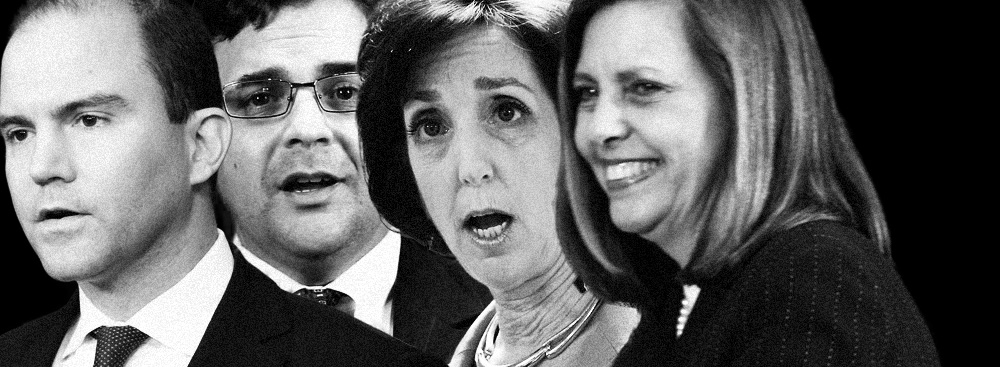Washington, D.C. – House Foreign Affairs Committee Chairman Ed Royce (R-CA) released the following statement today regarding the IAEA’s report on the “Possible Military Dimensions” of Iran’s past nuclear work:
“The IAEA report proves Iran lied. For years, the Iranian regime worked secretly to develop a nuclear weapon. And there are still important questions that remain unanswered. For example, how far did Iran get toward building a bomb? And what happened to all of the materials, research, and expertise Iran acquired?
“Iran’s long track record of obstructing investigators means the IAEA will face significant challenges moving forward – especially since the president’s nuclear agreement allows Iran to carry out self-inspections at key sites. Iran won’t even have to cheat to achieve advanced enrichment capacity, which puts them just a small step away from a bomb.”
In 2007, GW Bush was mislead by a flawed NIE, National Intelligence Estimate on the Iranian nuclear production program.
TWS: The authors of the 2007 NIE famously argued that the Iranians halted their nuclear weapons program in 2003 and had not restarted it since. The U.S. intelligence community defined “nuclear weapons program” as “Iran’s nuclear weapon design and weaponization work and covert uranium conversion-related and uranium enrichment-related work.” For no good reason, the NIE’s definition excluded “Iran’s declared civil work related to uranium conversion and enrichment.” More here.
Iran tried to build nuke weapons: UN report
TheHill: Iran carried out work to build a nuclear weapon in previous years, but that effort never passed initial stages, a United Nations agency said in a confidential report revealed on Wednesday.
The conclusion follows this year’s finalization of the international nuclear deal with Iran and is sure to prompt concerns about Tehran’s willingness to implement that pact
Yet the report from the International Atomic Energy Agency (IAEA), which was widely shared Wednesday, claimed that Iran carried out only preliminary steps to building a nuclear bomb and ceased those activities at least five years ago.
“[A] range of relevant activities to the development of a nuclear explosive device were conducted in Iran prior to the end of 2003 as a coordinated effort, and some activities took place after 2003,” IAEA said.
*** Now this month, December:
Next month, the International Atomic Energy Agency (IAEA) is scheduled to address one of the most important elements of the July 2015 Iran nuclear deal: Iran’s possible past nuclear weapons work, which the IAEA refers to as the “possible military dimensions” or the PMD of Iran’s nuclear program.
Although Obama officials had said Iran’s full cooperation with the PMD investigation was a prerequisite for the lifting of sanctions, this is no longer the case.
Resolving the PMD issue is important because this information is necessary to set a baseline for verifying the nuclear agreement. Secretary of State John Kerry made this clear in a July 24, 2015 speech when he said: “PMD has to be resolved before they get one ounce of sanctions relief. Now that could take six months, it could take a year. I don’t know how long. But the IAEA has to certify that all of that has been done and we have received our one- year breakout before they get a dime.”
There go the sanction….
WSJ: The Obama administration said it expects to start lifting sanctions on Iran as early as January after the United Nations’ nuclear watchdog found no credible evidence that Tehran has recently engaged in atomic-weapons activity. But the agency reported that the country had pursued a program in secret until 2009, longer than previously believed.
The mixed findings in the report, which also indicated that Iran showed limited cooperation with investigators, fueled critics who said the July nuclear deal between Iran and six world powers, as well as the White House’s move on Wednesday, were too easy on Tehran.
Iran has reached a historic agreement with major world powers over its nuclear program. What is Iran giving up, and how does it benefit in the long run? And what are supporters and critics of the deal saying? WSJ’s Niki Blasina explains.Nonetheless, senior U.S. officials said they expected the International Atomic Energy Agency’s 35-nation board of governors to vote this month to formally close its decadelong probe of Iran’s suspected past weapons work. International sanctions on Iran could then be lifted as early as January, U.S. officials said, once Tehran completes additional steps required to constrain its broader nuclear program.
“Iran has provided what [the IAEA] says was sufficient,” said a senior U.S. official working on the implementation of the Iran deal. “We had not expected a full confession [by Iran], nor did we need one.”
Wrapping up a five-month probe of Iran’s past activities, the IAEA said it believed Iran had a coordinated nuclear-weapons program until 2003 and that some of these activities continued as late as 2009.
The agency said the most-recent work Iran conducted on a weapon appeared to be through the use of computer modeling to develop components used in an implosion device. The agency said the work was done between 2005 and 2009.
“The modeling…has a number of possible applications, some of which are exclusively for a nuclear explosive device,” the report said.
The agency said there were no credible indications of nuclear-weapons-related activities in Iran after 2009. But it added that Iran provided little information on some points and offered some misleading responses.
Opponents of the nuclear deal in the U.S. Congress criticized the White House’s willingness to move forward with the pact, arguing Iran needed to provide significantly more answers to the U.N. agency. Some Republicans also demanded the U.S. refuse to lift the sanctions until Tehran complies.
“The IAEA’s report is dangerously incomplete and should be rejected by the IAEA Board of Governors,” said Rep. Mike Pompeo (R., Kan.), while Sen. Mark Kirk (R., Ill.), said, “The only clear point is that Iran stonewalled inspectors.”

